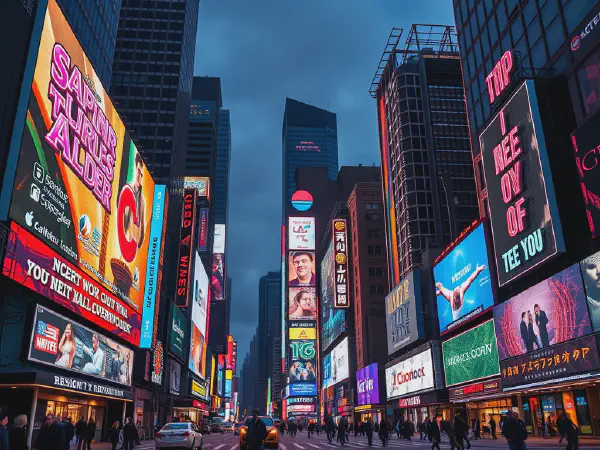Exploring Gigantic Signs: Impact and Design Trends

The Allure of Gigantic Signs: A Closer Look at Their Impact and Evolution
Gigantic signs have become a crucial aspect of modern advertising and public art, capturing the attention of passersby and creating lasting impressions. These larger-than-life displays serve not only as marketing tools but also as symbols that define cityscapes and cultural identities. The phenomenon of gigantic signs has evolved significantly over the years, blending technology, design, and marketing strategies to engage consumers in unique ways. From neon lights to digital screens, the creativity and innovation behind Gigantic Signs are ever-evolving, making them a fascinating subject worth exploring.
The historical significance of Gigantic Signs can be traced back to the early 20th century when outdoor advertising began to flourish. With the advent of electric lighting, businesses started to experiment with grand signage, creating visual spectacles that could draw attention from considerable distances. Over the years, iconic gigantic signs such as the Coca-Cola sign in Times Square and the Hollywood Sign in Los Angeles have become cultural landmarks, blending commercial intent with artistic expression. These signs have not only shaped local commerce but also influenced tourism, with many visitors seeking out these visual symbols of urban culture and identity.
In terms of design innovations, Gigantic Signs have undergone dramatic transformations. Modern materials such as LED screens and durable plastics have replaced traditional methods, allowing for more vibrant colors and diverse designs. Lighting techniques have also evolved, with many signs now incorporating dynamic lighting features that enhance visibility at night. Furthermore, eco-friendly design concepts are gaining popularity, as brands strive to balance impactful advertising with sustainability. By utilizing renewable energy sources and environmentally friendly materials, companies can create memorable displays while minimizing their ecological footprint.
Marketing strategies leveraging Gigantic Signs have become increasingly sophisticated, understanding the psychological impact of size and visibility on consumer behavior. Research has shown that larger signs can significantly enhance brand recall and engagement, making them a powerful tool in any advertising campaign. Successful case studies, such as the spectacular campaigns run by major brands during events like the Super Bowl, highlight how imaginative use of gigantic signage can elevate a brand's visibility. Moreover, the integration of gigantic signs with digital marketing strategies has opened new avenues for brands to reach their target audiences effectively.
However, the rise of Gigantic Signs is not without its challenges. Regulations and safety standards play a crucial role in the installation and maintenance of these signs. Local zoning laws dictate where and how such large signs can be placed, often requiring extensive permits to ensure compliance with community standards. Safety regulations also govern the structural integrity and electrical components of these signs, ensuring that they are safe for the public. Thus, businesses must navigate a complex landscape of regulations while pursuing creative and impactful signage solutions.
Historical Significance of Gigantic Signs
The evolution of signage through the years showcases how Gigantic Signs have adapted to meet the changing demands of advertising and urban aesthetics. Initially, painted board signs were the norm, evolving into illuminated signs that could attract customers both day and night. The iconic neon signs that emerged in the mid-20th century represented a cultural shift, celebrated for their vibrancy and artistry. As technology advanced, the introduction of digital displays pushed the boundaries further, allowing for dynamic advertisements that change in real-time. These historical shifts reflect broader trends in consumer culture and technology, marking key moments in advertising history.
Iconic gigantic signs around the world have become synonymous with their locations, serving as advertising beacons and tourist attractions. The 'Welcome to Fabulous Las Vegas' sign, the giant 'Mickey Mouse' sign outside Disneyland, and Toronto's CN Tower sign are prime examples of how large signs contribute to a city's identity. These signs often embody the character of a city and its history, earning their places in popular culture. They are not just advertisements; they are landmarks that tell stories and play a significant role in urban exploration.
The cultural impact of gigantic advertisements cannot be understated. They often reflect the prevailing values and aesthetics of their time, becoming symbols of consumer culture and artistic innovation. Gigantic signs frequently serve as backdrops for memorable moments, from movie scenes to social media posts, intertwining themselves with personal and collective experiences. As such, they transcend their original marketing purpose, gaining a cultural significance that contributes to their continued prevalence in urban spaces.
Design Innovations in Gigantic Signs
Materials used for durable gigantic signs have evolved remarkably with advancements in technology. Today, businesses can choose from a variety of robust materials such as aluminum, acrylic, and weather-resistant composites that ensure longevity and visibility. Innovations like LED technology have also transformed the landscape, producing brighter lights that consume less energy while maximizing impact. These modern materials and technologies enable designers to create intricate and eye-catching displays that stand the test of time.
Lighting techniques for night visibility have become a crucial aspect of gigantic sign design. Furthermore, the integration of advanced LED systems allows for color-changing displays and animated graphics that captivate onlookers at all hours. Dynamic lighting not only enhances visibility but also allows brands to update their messages easily and efficiently, keeping their advertising fresh and relevant. Innovations in lighting technology contribute significantly to the allure of these signs, making them indispensable in urban advertising.
Eco-friendly design concepts for signage are increasingly prioritized by businesses looking to enhance their brand image. Companies are exploring sustainable practices, such as using solar panels to power illuminated signs and utilizing recyclable materials in construction. Innovations also include LED lights that last longer and consume less energy compared to traditional options. The fusion of stunning design and environmental responsibility resonates with conscious consumers, allowing brands to engage in responsible marketing while making an impressive visual impact.
Marketing Strategies Utilizing Gigantic Signs
The psychological impact of large signs on consumers is profound, tapping into human perception in ways that smaller signs cannot. Research indicates that larger-than-life signs can command attention, instill a sense of urgency, and establish brand dominance in a crowded market. The emotional response elicited by such grand displays can be a powerful motivator for consumers, persuading them to engage with the brand. Understanding these psychological drivers enables marketers to craft effective strategies that center around gigantic signage's inherent appeal.
Case studies of successful campaigns utilizing gigantic signs highlight their effectiveness in creating memorable brand experiences. For example, during the launch of a new product, a prominent car brand erected a massive interactive sign that allowed viewers to engage through their smartphones, bridging the gap between physical and digital engagement. These types of campaigns not only attracted immediate attention but generated significant buzz on social media, amplifying their reach and impact. By examining these case studies, businesses can glean valuable lessons on harnessing the power of gigantic signage to connect with audiences.
Integrating gigantic signs with digital marketing strategies is becoming increasingly vital. The rise of social media platforms has encouraged brands to leverage eye-catching gigantic signs as shareable moments. Businesses can create larger-than-life experiences that directly engage their audience, prompting social sharing and interaction. Combining social media strategies with traditional signage creates a synergy that amplifies both reach and resonance, establishing a strong presence in today's fast-paced digital landscape.
Regulations and Safety for Gigantic Signs
Local zoning laws affecting sign placement are a crucial factor for businesses considering gigantic signs. Different municipalities have varied regulations that govern the size, location, and type of signage allowed. Adhering to these laws is not just about compliance; it ensures community standards are met and prevents legal complications. Many cities require permits for installation, leading businesses to navigate red tape effectively while planning their advertising strategies.
Safety standards for installation and maintenance are paramount to ensuring that gigantic signs do not pose a danger to the public. Regulatory bodies often stipulate certain criteria that all signage must meet to be deemed safe for installation, including structural integrity assessments and rigorous electrical inspections. These safety measures ensure that signs remain operational without risking harm, protecting both the business interests and the community.
Permits required for giant signage play an essential role in the advertising landscape. In many jurisdictions, businesses must submit detailed plans and documents to acquire the proper permitting before erecting promotional signs. These permits often require adhering to specific design guidelines and safety regulations, creating a path that businesses must follow to establish their desired impact. This process can be lengthy, but it ensures that signs contribute positively to their surroundings.
Future Trends in Gigantic Signage
Technology advancements in signage are rapidly evolving, with cutting-edge innovations paving the way for more immersive and engaging experiences. Augmented reality (AR) and interactive displays are being integrated into gigantic signs, allowing consumers to interact directly with the content and experiences presented. This shift represents a transition from passive consumption to active participation, reimagining what it means to engage with a brand in a physical space.
Augmented reality and interactive signs are leading the charge in engaging consumers on a personal level. Brands are exploring how to incorporate AR technology to create experiences that blend real and digital worlds, inviting users to participate in unique promotions or interact with the advertising displayed. This cutting-edge approach not only captivates attention but creates memorable experiences consumers are likely to share with others, further extending the brand's reach.
Sustainability trends in commercial signage are on the rise, as consumers increasingly prioritize eco-friendly practices. Businesses are exploring sustainable materials, energy-efficient lighting, and responsible production methods to create compelling signage that resonates with environmentally conscious audiences. The movement toward sustainability indicates a broader commitment within the industry to adapt to consumer demands and align with values that promote ecological stewardship.
